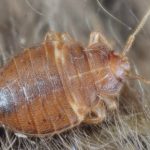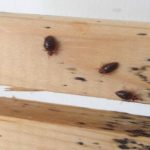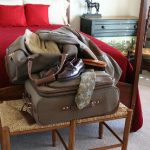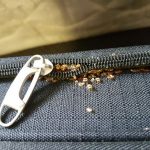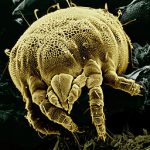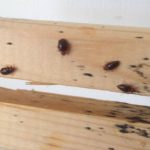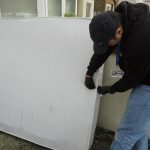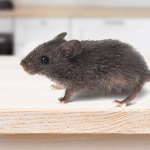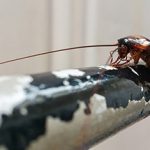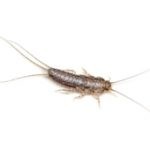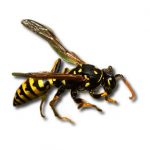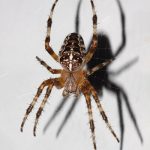What Do Bed Bugs Look Like to the Naked Human Eye?
One of the most definite, and typically the final, indicators of a bed bug infestation is seeing one with your own eyes. However, determining whether you have seen a bed bug can be challenging since its look changes with growth.
Small and brown, they are easy to mix with other home pests. Their skill for hiding under mattresses, blankets, and small furniture cracks also makes them more difficult to locate.
So, don’t panic if you just found a small bug on your bed! Not every tiny insect qualifies as a blood-sucking pest. Keep reading to find out how to spot bed bugs and determine whether an infestation is underway.
What does a bed bug look like?
To the naked human eye, bed bugs will appear as follows:
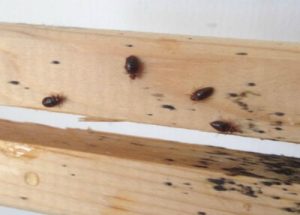
Adult bed bugs
The common adult bed bug looks like a baby cockroach, it’s the size of an apple seed – up to 5mm in size. It is light to reddish-brown in colour and has an oval, flat body when not fed. Bed bugs are wingless insects, they have 2 antennae and 6 legs that are not longer than their bodies. Each leg is around 1/2 of the total body length.
Both adults’ and nymphs’ bodies bulge, just like mosquitoes’ do when they’ve had a blood meal. Their size can increase 1-2 times, depending on the bug. Bed bugs need blood to survive and moult which is why they settle near people in the first place. You can easily spot adult bugs around the mattress, the box spring and the headboard.
Nymphs
The tiny baby bed bugs, also known as nymphs, are translucent tan in colour but turn opaque with maturity, after each moult. They moult a total of five times before reaching adulthood. Nymphs are no larger than a sesame seed. When fed, nymphs turn bright red due to all of the digested blood, this makes them easy to identify when noticed. However, their tiny size is the most likely reason why an infestation remains unrecognized for several weeks, allowing the bugs to grow and multiply.
Bed bug eggs
Bed bug eggs are whitish, the size of a poppy seed and have the form of an elongated capsule. In theory, you can see eggs with the naked eye but because of their miniature size, it’s quite difficult to recognise them if you’re not a professional. If you are inspecting a room, make sure to use a flashlight and a magnifying glass.
Bed bug eggs stick to the surface they were laid on, so removal techniques such as vacuuming are not an option if you were to remove them from a surface. Instead, try some of the other methods that do work.
Having a pest infestation in your property?
Rely on local specialist for effective bed bug treatment
Are bed bugs visible in all stages of their development?
Technically speaking, yes, however, they do a pretty good job at hiding. This makes it difficult to spot the insects, especially during the day when they aren’t that active. Why aren’t they active, you ask? Because bed bugs attempt to stay out of sight in order not to be squashed by you.
Instead of looking for a specimen, focus your efforts on pinpointing the different tell-tale signs of an infestation.
Finding any of these is a sure sign of an advanced bed bug problem.
What does a dead bed bug look like?
If a bed bug has been dead for a while, its body may look shrivelled or dry. Recently deceased ones are reddish-brown, but they can deepen or blacken as they decay. It may also look larger and darker if it ate before dying due to digested blood.
Bed bugs are frequently found dead on their backs with curled legs, resembling little cockroaches. They often emerge in beds and cracks, often with accompanying infestation symptoms like shed exoskeletons or faecal stains. If you see dead bed bugs, there’s a significant likelihood that some live ones are still hiding nearby.
What do bed bugs look like on a mattress?
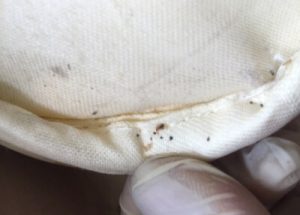 The first place to check for signs of bed bugs in your bed area and mattress in particular. These areas are the closest to their host – you. Bed bugs come out to feed when you are sleeping, blissfully unaware of their presence. It is then that they leave evidence of their presence. Check your mattress and bedding for:
The first place to check for signs of bed bugs in your bed area and mattress in particular. These areas are the closest to their host – you. Bed bugs come out to feed when you are sleeping, blissfully unaware of their presence. It is then that they leave evidence of their presence. Check your mattress and bedding for:
- Rusty or reddish spots caused by crushed bed bugs;
- Little dark spots the size of a pen mark which may bleed to the fabric, just like inc does. Those are bed bugs excrements;
You can also inspect the crevices and fabric folds of the mattress for:
- Eggs, eggshells, and cast skins which nymphs leave behind when moulting;
- Adult bed bugs and nymphs.
Read more: How to Get Rid of Bed Bugs
Why bed bug bites aren’t a sure sign of infestation?
Although bites are one sign of bed bug presence, they sure aren’t a conclusive one. This is due to a number of reasons:
A good strategy to rule for a bug infestation would be:
- Ensure there are bites.
- Find a bug.
- Then check if it is actually a bed bug.
You can start panicking if you’ve ticked “yes” on all three.
Insects that look like bed bugs
Looks can be deceiving. A number of insects appear similar to the bed bugs, so make sure to check for lookalikes before considering a treatment.
Some of the common UK household bugs that look like bed bugs include:
- Booklouse
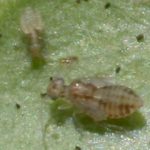 And more precisely, the booklouse nymph looks strikingly similar to a baby bed bug. Some wingless species are often mistaken for bed bugs and vice versa. However, these scavenging insects aren’t parasites and do not feed on human blood.
And more precisely, the booklouse nymph looks strikingly similar to a baby bed bug. Some wingless species are often mistaken for bed bugs and vice versa. However, these scavenging insects aren’t parasites and do not feed on human blood.
Image by: S. Rae
- Fleas
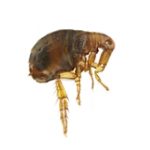 The only reason why people mistake fleas for bed bugs is their shared appetite for blood, visually they are nothing alike. So for example, if you see a tiny insect stuck to your arm at night, you may think at first that it’s a bed bug. But their diet is where the similarities end. Fleas, unlike bed bugs, aren’t parasitic to humans, they may bite you a couple of times, but their long-term hosts are animals.
The only reason why people mistake fleas for bed bugs is their shared appetite for blood, visually they are nothing alike. So for example, if you see a tiny insect stuck to your arm at night, you may think at first that it’s a bed bug. But their diet is where the similarities end. Fleas, unlike bed bugs, aren’t parasitic to humans, they may bite you a couple of times, but their long-term hosts are animals.
- Bat bug
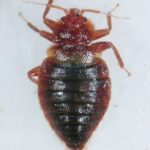 On the contrary, bat bugs are almost identical to bed bugs and the only way to tell the two apart is to observe them under a microscope. Bat bug’s prime host it the bat but they will feed on other warm-blooded animals, humans included if they wander away too far or the host is not available.
On the contrary, bat bugs are almost identical to bed bugs and the only way to tell the two apart is to observe them under a microscope. Bat bug’s prime host it the bat but they will feed on other warm-blooded animals, humans included if they wander away too far or the host is not available.
Image by: Gilles San Martin
If you’re still unsure whether you’ve spotted a bed bug, trap the insect and show it to an experienced bed bug exterminator to get a professional opinion.
Check also: Bugs that Look Like Bed Bugs
Get your home inspected by a certified pest technician!
Keep in mind that we only aim to provide some useful information about how to recognise bed bugs with bare eye and how do they look like. We cannot guarantee that the bugs you’re dealing with corresponds to the same description and are exactly bed bugs.



